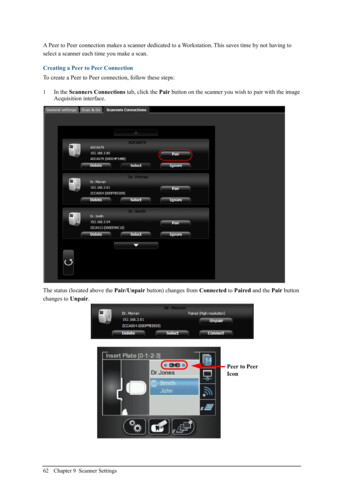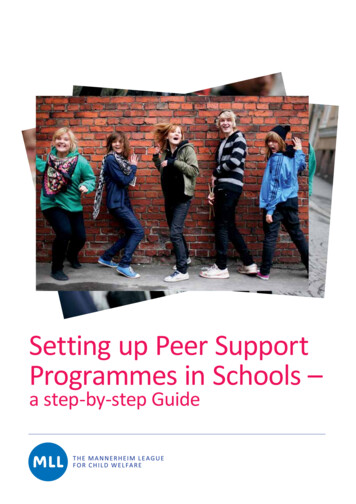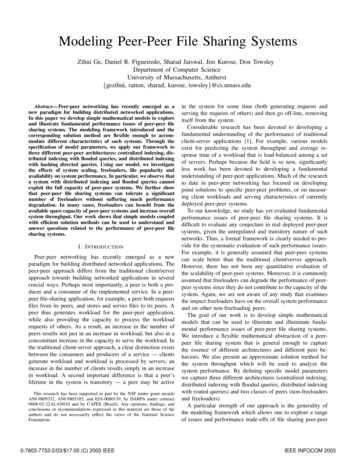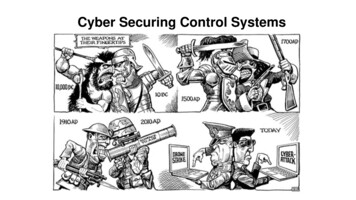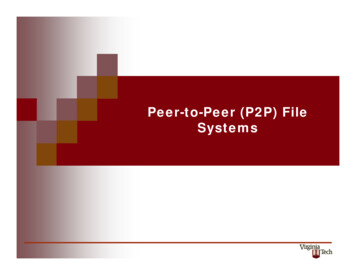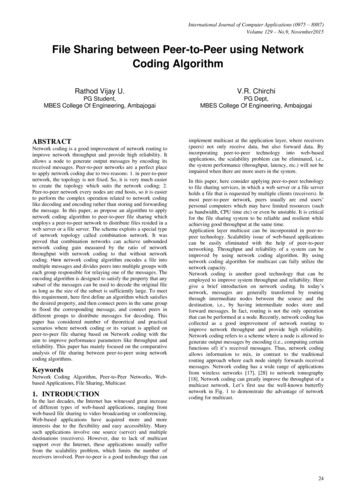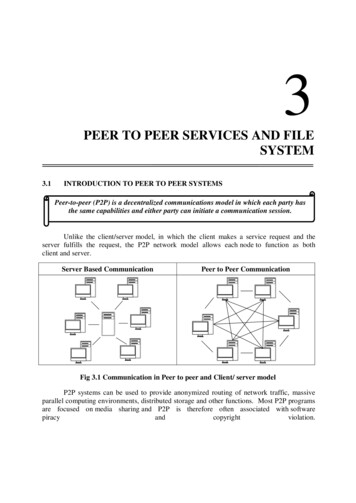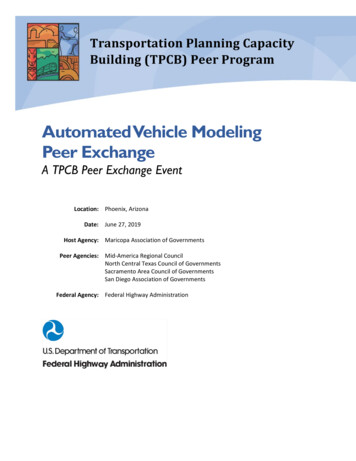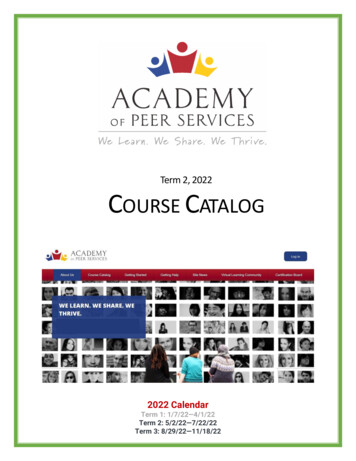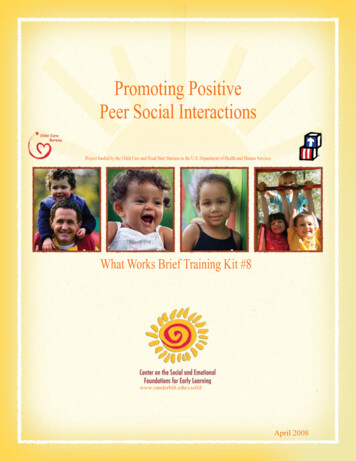
Transcription
Promoting PositivePeer Social InteractionsProject funded by the Child Care and Head Start Bureaus in the U.S. Department of Health and Human ServicesWhat Works Brief Training Kit #8www.vanderbilt.edu/csefel/April 2008
The What Works Brief Training Kits were developed to help in-service and pre-serviceproviders conduct staff development activities. Each kit is based on one What Work Briefand contains the following items: presenter’s PowerPoint note pages, participant handouts,activity ideas, pre-training survey, demographic form, training evaluation, and trainingcertificate.The What Works Brief Training Kits are grounded in the Pyramid model depicted below,which provides a framework for describing the four interrelated levels of practice that addressthe social and emotional development of all children. The Pyramid is designed to guidepractitioners in understanding the importance of children’s social-emotional competence interms of school readiness and the prevention of challenging behavior. This What Works BriefTraining Kit relates to the “High Quality Environments” level of the Pyramid.We welcome your feedback as you provide professional development activities with thesematerials.Special thanks to the Meginnis Endowment at UIUC for funding to help support this effortand to the following individuals who developed the What Works Brief Training Kits materials:Micki Ostrosky, Hedda Meadan, Greg Cheatham, Monique Mills, Sallee Beneke, NancyGaumer, Amy Hayden, Elenor Rentschler, and Angel Fettig.
Presenter NotesWWB Training Kit #8Promoting Positive PeerSocial InteractionsPresenter PowerPointSpeaker Notes: Presenter should be familiar with the content in What Works Brief #8 and Module2, Section III on Developing Friendship Skills (available at http://www.vanderbilt.edu/csefel/). Consider using the What Works Brief # 8 handout as a supplemental resource. Welcome participants. Take care of any logistics (e.g., length of time for session, break, handouts, etc.). Pass out pre-training survey for all participants to complete and turn in if desired. As you present the workshop: Remind participants to take the culture andbackground of children into consideration and to work hand-in-hand with parentswhen they select target behaviors, since some behaviors may be part of the child’sculture.
Positive Peer Social Interactions Interactions that take place between peers thatare positive in nature and successful for bothchildren involvedSpeaker Notes: Defining positive peer social interactions. Example of positive peer social interaction:Two little girls playing in the dramatic play area, laughing and talkingas they pretend to play house. Group discussion:Can you think of any other positive peer social interactions?
Children with Positive Peer SocialInteractions Tend to Have: Positive social and emotional developmentPopularity among peersStronger friendshipsMore opportunities for classroom activity inclusionSpeaker Notes: Note that research supports these four reasons to facilitate positive peersocial interactions.
Children with Positive Peer SocialInteractions Display a limited number of the following negativepeer interactions: Grabbing Pushing Name calling Engagement in negative socialinteractions at homeSpeaker Notes:Research supports these outcomes.
Positive Social SkillsSample target social skills include: Getting a friend’s attentionSharing objectsAsking a peer to share objectsProviding a play idea to a peerSaying something nice to a friendEntering group playSpeaker Notes:These are commonly identified social skills that are noted as being importantfor successful peer interaction. Getting a friend’s attention: “Amanda, let’s do a puzzle.”Sharing objects: “Sallee, here’s some playdoh.”Asking a peer to share objects: “Greg, can I have a block?”Providing a play idea to a peer: “Monique, let’s build a zoo!”Saying something nice to a friend: “Thanks for the scissors, Amy.”Entering group play: “Here’s a cage for the lions.”See clips 2.2 – 2.5 at http://www.vanderbilt.edu/csefel/preschool.html forexamples of positive social skills.
Direction Teaching of Social Skills1. Explain the skill (e.g., teach greeting or sharing)2. Demonstrate the correct way to use it3. Demonstrate an inappropriate way and allowchildren to problem solve4. Let a children practice the skill with an adult or withanother child5. Provide positive feedback and attention on use ofthe skillsSpeaker Notes:This slide contains ideas for teaching social skills to your children. Strategies for teaching targetsocial skills may vary depending on cultural and developmental differences in children.Cultural Differences Direct eye contact may or may not be valued in every culture. Children may be resistant tolooking their peers in the eye while asking them to play. Teachers can validate home culturesby saying “Maria, I know that at home children do not look directly in other peoples’ faces. Atschool it is ok for you to look directly in other peoples’ faces. In fact, I want you to! I have talkedto your (primary caregiver) and s/he wants you to know that this is acceptable.”Developmental Differences Teachers may give children with developmental disabilities, who may be nonverbal, a picturecard to communicate. Most children with special needs need direct teaching to acquire positive social skills.Cognitive Differences Instructor should consider the mode of communication (verbal, visual, tactile, auditory), aschildren learn best in different ways.Direct teaching format can be group or individual.
Adults May Support Children in UsingSocial Skills by: Monitoring during play and large group time Cueing children to play together, share with theirfriends, and be persistent Modeling positive peer interaction other adults inthe classroom Including cooperative use toys in the classroomSpeaker Notes: Monitoring: Watching the child during center time or play and promptingor providing feedback regarding social skills. Cueing: Prompting one child to share with another or prompting a childto ask his friend again or ask another way (being persistent); use ofdifferent modalities (e.g., visual, auditory, tactile, verbal) Modeling: Asking the other adult in the classroom to please pass you anobject and saying thank you when you get the object Cooperative toys: See next slide and refer to What Works Brief #6
Cooperative Use Toys Balls Dress-up clothes Puppets Rocking boats Two telephones Wagons Dramatic playmaterials Board games Teeter-totters Tire swingsSpeaker Notes:Here are some examples of toys that increase the opportunities for socialpeer interaction between two or more people. Cooperative use toys set the stage for cooperative play. Cooperative toys require at least two children.Refer to What Works Brief #6 for more on cooperative toys.
Adults May Support Children inImplementing Strategies by: Giving specific verbal cues, praise, andsuggestions Giving material reinforcers Providing physical assistance Embedding planned socialinteractionsSpeaker Notes:Verbal Cues “Remember to tap him on the shoulder.” “Danielle, ask Joshua for a paintbrush.” “Remember to look at him, tap him on the shoulder and say his name, then give him the block.” Limitation: Verbal cues may stop the natural flow of communication.Praise “Thank you for handing Danielle a paintbrush.”Suggestions “You two can finish painting the house together using the rollers.” “Why don’t you hand Billy a block?”Material Reinforcers For example, “superstars” are necklaces the teachers and children have. When the teacher observes a child using the targetsocial skill naturally during play, s/he could reinforce this behavior by giving the child a superstar. Other material reinforcers include hearts, friendship capes, etc. Limitations: Material reinforcers may encourage students to focus on extrinsic rather than intrinsic rewards associated withsocially interacting with others.Provide Physical Assistance Children with physical disabilities may need hand-over-hand assistance in tapping peer on shoulder to initiate social interaction. Some children may need to be prompted to use social skills. For example, a child with a language delay may need to bephysically led over to the easel and assisted with handing a picture from the communication board to a peer to request aconversational turn or object.Planned Social Interactions Passing out names for jobs at circle Passing out napkins at snack Choosing a friend to help feed birdsDiscussion Questions Why would a teacher be cautious about use of material reinforcers? Pros: Encourages children who are reluctant to engage with others. Cons: Teaches children to focus on extrinsic rather than intrinsic rewards associated with socially acting with others.
ActivityPair-Think-Share Pair with a partner Think about ways you can embed social interactionopportunities into the four classroom routinesprovided Share your thoughts with thelarge groupSpeaker Notes: Assign partners. Pairs should think about ways you can embed social interaction opportunitiesinto four classroom routines. Complete the chart. Share thoughts with the large group by having a few groups share their ideas.
Activity 1RoutineArrivalOpportunity to use social r Notes: Think of ways you can embed social interaction instruction and practiceopportunities into four classroom routines in your center, program, orschool.
Additional Resources http://www.vanderbilt.edu/csefel/preschool.html. “You’ve got tohave friends” article in Module #2. Chandler, L. (1998). Promoting positive interaction betweenpreschool-age children free play: The PALS center. YoungExceptional Children, 1(3), 14-19. LEAP Outreach Project. (2003). Nurturing social skills in theinclusive classroom: Staff workbook. Tualatin, OR: Teacher’sToolbox. Taylor, A. S., Peterson, C. A., McMurray- Schwarz, P., &Guillou, T. S. (2002). Social skills interventions:Not just for children with special needs. YoungExceptional Children, 5(4), 19-26.Speaker Notes: This slide contains additional resources participants can use to find moreinformation on using environmental strategies to promote positive socialinteractions. Refer to the website and read the article entitled “You’ve Got to HaveFriends” in Module #2. This article contains: A list of cooperative toys Example of a scheduled with embedded friendship opportunities Strategies for friendship development Thank the participants for participating and have them complete theevaluation form, if appropriate. Distribute the certificate of attendance if appropriate.
Pre-training SurveyWWBTK #8: Promoting Positive Peer Social InteractionsR What are some benefits to children’s positive peer social interactions?R What are two strategies you can use to support children’s positive peer social interactions?R What are two cooperative toys that can be used to promote children’s positive peer socialinteractions?R What are the three most pressing issues you face as an early childhoodprofessional?1.2.3.
Pre-training SurveyWWBTK #8: Promoting Positive Peer Social InteractionsDemographic InformationDescribe yourself (check the boxes that best describe you):R Your gender: Female MaleR Your age: under 30 31 to 40 41 to 50 51-60 61 and aboveR Your ethnicity: European American Asian-Pacific Hispanic African-American American Indian Other (specify)RCheck your current teaching certificates: Early Childhood Education Elementary Education Special Education Other (Specify)RCheck the one that best describes your education: High school or GED Some college Associate’s degree Bachelor’s degree Master’s degree Other (Specify)RRRYour teaching experience:How many year(s) have you taught preschoolers?How many year(s) have you taught preschoolers with IEPs?Thank you for completing this survey.CSEFEL
Participant NotesNotesWWB Training Kit #Promoting PositivePeer Social InteractionsParticipant PowerPointPositive Peer Social Interactions Interactions that take place between peersthat are positive in nature and successfulfor both children involved.Children with Positive Peer SocialInteractions Tend to Have: Positive social and emotional development Popularity among peers Stronger friendships More opportunities for classroomactivity inclusion
Children with Positive Peer SocialInteractions Display a limited number of the followingnegative peer interactions: GrabbingPushingName callingEngagement in negative socialinteractions at homePositive Social SkillsSample target social skills include: Getting a friend’s attentionSharing objectsAsking a peer to share objectsProviding a play idea to a peerSaying something nice to a friendEntering group playDirection Teaching of Social Skills1. Explain the skill (e.g., teach greeting orsharing)2. Demonstrate the correct way to use it3. Demonstrate an inappropriate way andallow children to problem solve4. Let a children practice the skill with an adultor with another child5. Provide positive feedback andattention on use of the skillsNotes
Adults May Support Children in UsingSocial Skills by: Monitoring during play and large group time. Cueing children to play together, share withtheir friends, and be persistent Modeling positive peer interaction otheradults in the classroom Including cooperative use toys inthe classroomCooperative Use Toys Balls Rocking boats Puppets Wagons Two telephones Board games Dramatic playmaterials Tire swings Teeter-totters Dress-upclothesAdults May Support Children inImplementing Strategies by: Giving specific verbal cues, praise, andsuggestions Giving material reinforcers Providing physical assistance Embedding planned socialinteractionsNotes
Additional Resources �You’ve got to have friends” article in Module #2. Chandler, L. (1998). Promoting positive interactionbetween preschool-age children free play: The PALScenter. Young Exceptional Children, 1(3), 14-19. LEAP Outreach Project. (2003). Nurturing social skillsin the inclusive classroom: Staff workbook. Tualatin,OR: Teacher’s Toolbox. Taylor, A. S., Peterson, C. A., McMurraySchwarz, P., & Guillou, T. S. (2002).Social skills interventions: Not just forchildren with special needs. YoungExceptional Children, 5(4), 19-26.Notes
Activity 1Using Self-Management in Your SettingWWBTK #8: Promoting Positive Peer Social InteractionsCSEFELR Directions:Think about ways children can use self-management within different settings their(center/school). What are some obstacles in the setting that keep children from usingself-management techniques? Share thoughts with the large group.RoutineArrivalCenter TimeOustideSnackTransitionsOpportunities to use positive social skillsOne child is assigned to be the “greeter” and greets children by name asthey arrive
CSEFEL Training Workshop EvaluationWWBTK #8: Promoting Positive Peer Social our position:R Circle the number that best expresses your reaction to eachof the following items:1. This topic is important to me.(Extremely Important)4 3 2 1 (Not Important at All)2. The amount of information covered was(Just Right)4 3 2 1 (Inadequate)3. The information covered was clear.(Very Clear)4 3 2 1 (Vague)4. The activities conducted were beneficial.(Very)4 3 2 1 (Not at All)5. The handouts provided were useful.(Very)4 3 2 1 (Not at All)6. Overall, this presentation was(Very Useful)4 3 2 1 (Not Useful)R Things I liked about this presentation:R Things I would change about this presentation:R Additional information I would like on this topic:R New things I am going to try as a result of this workshop:R Additional comments:
Cer tificate of TrainingPromoting Positive Peer Social InteractionsThis is to certify thatsuccessfully completed the above trainingTrainerParticipantTrainerDate and LocationAdditional training resources are available at: http://www.vanderbilt.edu/csefel/
Positive Social Skills Sample target social skills include: Getting a friend's attention Sharing objects Asking a peer to share objects Providing a play idea to a peer Saying something nice to a friend Entering group play Direction Teaching of Social Skills 1. Explain the skill (e.g., teach greeting or sharing) 2.
